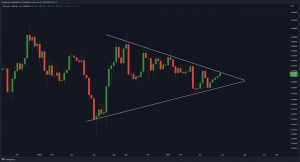Bitcoin Ether Etf Performance Insights For Investors
Kicking off with bitcoin ether etf performance, this discussion delves into the intriguing world of exchange-traded funds tailored for Bitcoin and Ether. As these digital assets continue to capture the interest of investors, understanding their ETF performance becomes crucial for making informed investment decisions.
From their historical emergence in the financial landscape to the various factors influencing their performance, Bitcoin and Ether ETFs offer a unique perspective on the evolving cryptocurrency market. By examining performance metrics, investment strategies, and future outlooks, investors can better navigate the complexities of these innovative financial instruments.
Overview of Bitcoin and Ether ETFs
Bitcoin and Ether ETFs (Exchange-Traded Funds) have gained significant attention in recent years as financial instruments that offer investors exposure to cryptocurrency without the need to directly hold these digital assets. ETFs are designed to track the performance of an underlying asset, in this case, Bitcoin and Ether, allowing investors to buy shares that represent a fraction of the fund's holdings.The emergence of Bitcoin and Ether ETFs can be traced back to the growing acceptance of cryptocurrencies in the mainstream financial market.
Bitcoin, the first cryptocurrency, was created in 2009, and Ether followed in 2015. The demand for investment vehicles that provide access to these cryptocurrencies led to the development of ETFs, which began gaining traction in the early 2020s. When it comes to the specifics of Bitcoin and Ether ETFs, there are notable differences. Bitcoin ETFs primarily focus on the price movements and performance of Bitcoin itself, while Ether ETFs target Ethereum’s native cryptocurrency, Ether.
Additionally, the underlying technology and use cases of these cryptocurrencies differ, with Bitcoin serving as a digital gold and Ether functioning as a utility token within the Ethereum ecosystem.
Factors Influencing ETF Performance

The performance of Bitcoin and Ether ETFs is influenced by various factors that reflect the broader cryptocurrency market dynamics. Key factors include:
- Market Trends: Trends in the cryptocurrency market, such as bullish or bearish sentiment, directly impact ETF valuations. For instance, a surge in Bitcoin prices typically leads to an increase in Bitcoin ETF performance.
- Investor Sentiment: Public perception and sentiment toward cryptocurrencies can drive investment decisions. Positive news surrounding Bitcoin or Ether can lead to increased inflows into their respective ETFs.
- Regulatory Frameworks: The regulatory environment plays a critical role in shaping the performance of these ETFs. Clear regulations can enhance investor confidence, while uncertainty can lead to volatility.
Performance Metrics for Comparison

To evaluate the performance of Bitcoin and Ether ETFs, several key metrics are commonly used:
| Metric | Bitcoin ETFs | Ether ETFs |
|---|---|---|
| Returns | Annualized returns over different periods | Annualized returns over different periods |
| Volatility | Standard deviation of returns | Standard deviation of returns |
| Liquidity | Average trading volume | Average trading volume |
Monitoring these metrics over varying time frames is essential for investors. Short-term metrics may indicate market reactions to news, while long-term trends can reflect the overall growth and stability of the cryptocurrency market. This dual approach provides a comprehensive view of ETF performance.
Investment Strategies for Bitcoin and Ether ETFs
Investing in Bitcoin and Ether ETFs can be approached through various strategies that align with an investor's financial goals and risk tolerance. Some effective strategies include:
- Diversification: Including both Bitcoin and Ether ETFs in a portfolio helps mitigate risk, as these cryptocurrencies often react differently to market events.
- Dollar-Cost Averaging: Regularly investing a fixed amount in Bitcoin and Ether ETFs can help reduce the impact of volatility and lower the average purchase price over time.
- Active Management: Monitoring market trends and adjusting allocations based on performance metrics can enhance returns and manage risk effectively.
Historical Performance Analysis
Examining the historical performance of Bitcoin and Ether ETFs reveals significant insights into their stability and responsiveness to market conditions. The following table illustrates key past performance data:
| Year | Bitcoin ETF Performance | Ether ETF Performance |
|---|---|---|
| 2020 | +300% | +500% |
| 2021 | +60% | +400% |
| 2022 | -70% | -80% |
Significant events in the cryptocurrency space, such as regulatory news, technological advancements, and market crashes, have historically influenced ETF performance. Patterns of rapid growth followed by corrections are common, highlighting the importance of strategic investment approaches.
Future Outlook for Bitcoin and Ether ETFs
The future performance of Bitcoin and Ether ETFs is shaped by ongoing trends and potential market shifts. Predictions indicate continued growth for these ETFs, driven by:
- Institutional Adoption: Increasing interest from institutional investors could enhance liquidity and drive prices higher.
- Regulatory Developments: Positive regulatory changes, such as clearer frameworks for cryptocurrency trading, may bolster ETF performance.
- Technological Advancements: Innovations within blockchain technology and decentralized finance (DeFi) could provide new growth avenues for Ether ETFs, in particular.
Emerging trends such as ESG (Environmental, Social, and Governance) investing may also influence future ETF structures and offerings, making them more appealing to a broader range of investors.
Final Thoughts

In summary, the performance of bitcoin and ether ETFs presents both opportunities and challenges for investors. As the market continues to evolve and regulatory frameworks develop, staying informed about trends and performance metrics will be essential for maximizing investment potential. The future holds exciting possibilities for these ETFs, making them an intriguing area for any savvy investor.
Q&A
What are Bitcoin and Ether ETFs?
Bitcoin and Ether ETFs are exchange-traded funds that allow investors to gain exposure to the performance of Bitcoin and Ether without directly owning the cryptocurrencies.
How do market trends affect ETF performance?
Market trends and investor sentiment can significantly influence the valuation of Bitcoin and Ether ETFs, as they reflect the overall demand for these digital assets.
What metrics are used to evaluate ETF performance?
Key metrics include returns, volatility, and liquidity, which help investors assess the performance and risk of their investments in these ETFs.
Why is diversification important when investing in ETFs?
Diversification helps mitigate risk by spreading investments across various assets, reducing potential losses from any single investment.
What future trends may impact Bitcoin and Ether ETFs?
Emerging trends may include advancements in cryptocurrency regulation, technological developments, and changing investor preferences that could shape the performance landscape of these ETFs.


